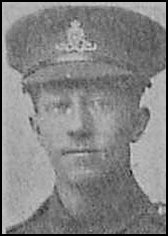Category: Military
Rank: Gunner & Sapper 359411
Regiment or Ship: Royal Garrison Artillery & Royal Engineers.
Service Number(s): 101102 & 359411
Occupation: Grocer’s Assistant
Date of Birth: 1886
Place of Birth: Edenbridge, Kent
Date of Death: 12.07.1935
Place of Death: Battle district (probably Bexhill).
Place of Burial / Memorials:
Bexhill Cemetery (buried: 15 July 1935), Plot: EEE14.
Address: 52 Parkhurst Rd, Bexhill
Photos and newspaper articles
Family Information
Parents: Edward Blundell, born in 1846 in Tonbridge, Kent and Harriet Manktelow, born in 1849 in Wadhurst, Sussex. They were married in 1869, in the District of Ticehurst (most probably in Wadhurst)
Siblings:
William Blundell, born 1869 in Tonbridge, Kent
Rose Blundell, born in 1872 in Wadhurst, Sussex
Edward Blundell, born in 1874 in Edenbridge, Kent
Emily Blundell, born 1876 in Edenbridge, Kent
Harriet Blundell, born in 1879 in Edenbridge, Kent
Edith Kate Blundell, born in 1886 in Edenbridge, Kent
Florence Blundell, born in 1890 in Edenbridge, Kent
Spouse: Charles George Blundell married Daisy Lydia Knapp, on 9th June 1914 at Hadlow Down.
At some time before 1916, they seem to have moved to Bexhill where they had two children: Betty Lydia Blundell, born in Bexhill, on 6th January 1916 and Douglas Charles Edward Blundell born in 1921.
First World War Experience
Charles George Blundell was attested at Bexhill on 9th December 1915, enlisted, as a private, into the 12th Battalion of the Royal Sussex Regiment, and given the service no. 101102.
He was posted to the “A” Siege Depot of the Royal Garrison Artillery with the rank of “Gunner” on 6th July 1916.
On 28th April 1917, he was transferred to the Royal Engineers, as a sapper (regimental number 359411) but later on moved to the Signals section. His service records say that he was gassed on 31st October 1918 but no details as to where or when have been given. There is, however, a small, plain sheet of paper among his service records, across the top of which someone has written the words “Inside Sheet” and, underneath, his service number, 359411, and name “Blundell C”. Underneath that is written “B178 sent to first Southern General Hospital, King’s Heath Inst. Birmingham” but no further details are given.
During his time in the army, Charles’s only misdemeanour appears to have been to go absent without leave. His ‘Company Conduct Sheet’, Army Form B122, gives his service number, 359411, his name, and that, at the time, he was serving in the Royal Engineer, Signals section. It then goes on to report that, on 25th February 1919, he was ‘Absent Without Leave’ from 12 o’clock (mid-day) until he was caught and ordered to return to his unit, by the Military Police, at 22 minutes to 11 o’clock in the morning of the following day (26th February 1919)
His punishment was that, instead of a trial, he was to forfeit two days pay and to be confined to barracks for seven days.
According to his records, he was 5ft 7inches tall with a 34 inch chest, when fully expanded.
The “1st Southern General Hospital” in Birmingham was just one of many large military hospitals that were developed to treat the flood of casualties coming back to Britain from the war fronts and the training centres in the United Kingdom.
However, interestingly, his records say that he was taken to “first Southern General Hospital, King’s Heath Inst. Birmingham”. The “Inst.” must refer to the “Kings Heath Institute”, which was built in 1878 and became the centre of life in the community for many years. It housed a library, assembly room and lecture theatre, hosted functions, dances and was the base of many societies such as drama and opera. Woolworths leased the ground floor in the 1930s and the building was demolished in the 1970s to make room for a new Woolworths shop ; “Institute Road” is the only reminder of its location.
So far, however, no evidence has been found that the Institute was converted into a hospital and that that was where Charles went.
The Bexhill Observer, dated 18th January 1919, reports as follows: –
“BEXHILL SOLDIER GASSED”
“Sapper C. G. Blundell, Royal Engineers, whose home is at 52, Parkhurst-road, was gassed when acting as medical orderly, and has been undergoing treatment in hospital at Birmingham. He is progressing, and was able to come home at Christmas.”
Other Burials
Buried with Charles, in the same plot (EEE14), are his wife, Daisy Lydia Blundell, who died on 15th June 1976, and his daughter, Betty Lydia Beaney, died 18th June 1996, aged 80.
Strangely enough, there is no record of Betty Lydia Blundell marrying anyone but, from the original indexes, there is a Cicely W. D. Blundell marrying a Frederick G. Beaney, in 1934, in the district of Battle – unfortunately, Frederick, from the same original documents actually appears to have married Cicely W. Dawson-Blundell (that’s what the ‘D’ stood for –Dawson). Searching for a marriage of a Dawson to a Blundell, however, came up with nothing – it’s a tantalizing mystery!
There are also, in the Bexhill Cemetery records: –
Susannah Blundell, who died on 30th March 1926 and is buried in Plot BEF07.
Mary Blundell, who died on 11th March 1942 and is buried in Plot DCC18
These do not seem to be related to Charles Blundell but they might be.


